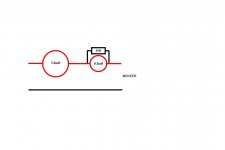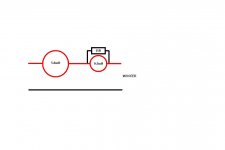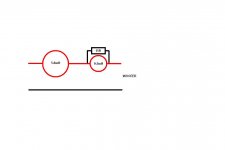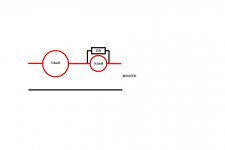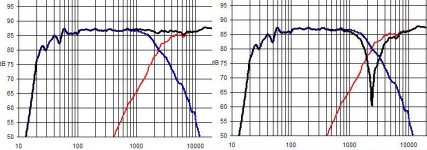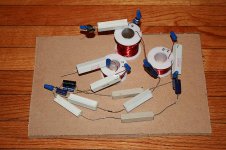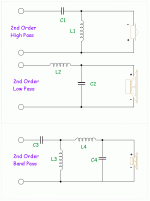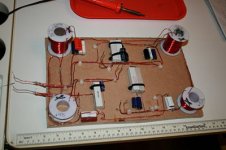Edit!!!!
"Not to mention the added benefit of being able to test summed capacitance, voice coil impedance ect.. for myself!"
I meant voice coil INDUCTANCE.
"Not to mention the added benefit of being able to test summed capacitance, voice coil impedance ect.. for myself!"
I meant voice coil INDUCTANCE.
rabbitz said:I haven't used that driver but have done several using the older 850488 and that could be crossed over successfully between 3k-3.5k using 1st order networks.
The FR roll off only gives a small part of the story as even though the roll off can look good with the filter in place, the sonics can suffer. The P13 is a good example and sounds better when crossed over lower than it's perceived capabilities. I've just done a 5" SEAS where the response looked good enough to crossover around 3.5k but had to cut it off at the nuts below 2.5k as it became edgy.
Bill
Don't get hung up on the 10% thing. There used to be rules on 3-ways where you have a 3 octave or 3.4 octave spread between the crossover points but I think that was a lot to do with design formulae. Keeping the spread above 3 octaves (Fh/Fl=8) is a good idea and you find a lot of 3-ways presented here and on sites are way above that as builders are tending to cross over the woofer to mid much lower as there is a trend away from dedicated mids to mid woofers which can be pushed lower.
The summed FR is one thing but you really have to check how the drivers are summing at each crossover point (phase etc) and the easiest is checking the reverse null to see if it's nice and deep. If that's the case, then the phase at the crossover point is good.
That said, I've never had complete success with 3-way filters that I was completely happy with.... sounded good but not great.... so I'm not the best guide.
Thank you Rabbitz for your advice!
One question if I may, does "reverse null" mean the same thing as reverse polarity?
Thanks, Bill.
Just "found" a new woofer crossover
I wont claim its an invention, but I have never seen it used like this
On my speakers I experience a much more tight and articulated and rythmik bass
Another side effect is even more articulated midrange and softer highend
Ofcourse its very much system related, and must fit the rest of the crossover chain
I wont claim its an invention, but I have never seen it used like this
On my speakers I experience a much more tight and articulated and rythmik bass
Another side effect is even more articulated midrange and softer highend
Ofcourse its very much system related, and must fit the rest of the crossover chain
Attachments
Hi Bill,
Ted (Moondog) posted a link to Rod Elliott's site. I, like him, am a convert to fully active. You may have read the article by now, however, these two quotes are worthwhile in themselves;
Frank
Ted (Moondog) posted a link to Rod Elliott's site. I, like him, am a convert to fully active. You may have read the article by now, however, these two quotes are worthwhile in themselves;
A fully active system (using electronic crossovers and separate amps for all drivers) will almost certainly give a better result than the most carefully designed passive system, and may even work out cheaper ... Some passive crossover networks can become very complex and expensive indeed.
One thing that should be quite clear by now, is that a full 3-way passive crossover, with everything done properly will be very expensive to build. It is also time consuming, and the final result will only ever be as good as the effort you are willing to put into getting everything right.
Frank
It was quite interesting to read a manufactorer of active crossovers say that his active filter would improve most speakers with passive filters, EXCEPT the ones working properly with passive
They should better be left untouched
But probably not many of those around anyway
I have always had a suspicion that mr Elliot may not be too good with handling passive crossovers
That said, I also have the opinion that passive 3ways are close to impossible, and will always be somewhat flawed by nature
Though, mr Linkwitz knows that "standard" active filters arent perfect either
Both passive and active rely on the same basics, which is that all drivers own natural rolloff has to be calculated into the filters, whether its passive or active
This means that even with fully adjustable digital crossovers, you still need acoustic measurements
Measurements that may not even be reliable at all
The problem remains
They should better be left untouched
But probably not many of those around anyway
I have always had a suspicion that mr Elliot may not be too good with handling passive crossovers
That said, I also have the opinion that passive 3ways are close to impossible, and will always be somewhat flawed by nature
Though, mr Linkwitz knows that "standard" active filters arent perfect either
Both passive and active rely on the same basics, which is that all drivers own natural rolloff has to be calculated into the filters, whether its passive or active
This means that even with fully adjustable digital crossovers, you still need acoustic measurements
Measurements that may not even be reliable at all
The problem remains
Attachments
The problem remains the same
How so? Many of the problems associated with a passive design can be eliminated by fully active. Speakers can be considered individually, ie, there is no interaction between them except to choose a croosover frequency.
Frank
Francec said:
there is no interaction between them except to choose a croosover frequency.
Frank
Oh yes, theres still a lot of interaction on the acoustic side, the most important one
Stricktly speaking
As a minimum you need individually independably and fully adjustable xo points for each driver
Slopes need to be fully adjustable, no fixed slopes will do
But in some cases less will do fine though
I admit, I will be awaiting to look closer at the announced Hypex digital filter

On the other hand, my next speaker will be 2way, so a passive will be much less of a problem
But in the end it may be a matter of what to expect, but to say a "standard" active filter is perfect is simply wrong
Could still work ok though
But the result may vary a lot with the choise of drivers
Attachments
tinitus said:Just "found" a new woofer crossover
I wont claim its an invention, but I have never seen it used like this
On my speakers I experience a much more tight and articulated and rythmik bass
Another side effect is even more articulated midrange and softer highend
Ofcourse its very much system related, and must fit the rest of the crossover chain
Thanks for the post!
How does one calculate the values for this configuration?
Bill.
Francec said:Hi Bill,
Ted (Moondog) posted a link to Rod Elliott's site. I, like him, am a convert to fully active. You may have read the article by now, however, these two quotes are worthwhile in themselves;
Frank
Thanks for the post Frank!
I liked Rod's articles. He makes a fairly bullet proof arguement for active crossovers! Right now I'm broke and can't afford the investment. I'm going to finish this passive crossover come Hell or high water, if for no other reason than my own sanity.

Bill.
I disagree. As long as the drivers have a flat response and the response extends past the crossover points, a 24dB crossover with fixed points will be fine. Such a steep slope obviates most problems simply because it does not allow a 'problem' to exist. Most speaker roll off less than 24dB per octave.Stricktly speaking As a minimum you need individually independably and fully adjustable xo points for each driver Slopes need to be fully adjustable, no fixed slopes will do But in some cases less will do fine though
Speaker choice is always the primary consideration, however, active allows a wider choice of drivers because driver roll off, for the most part, does not have to be considered. It only has to be less than 24dB per octave. Equally, driver impedances will not react with each other in an active setup.But in the end it may be a matter of what to expect, but to say a "standard" active filter is perfect is simply wrong Could still work ok though But the result may vary a lot with the choise of drivers
With such good results and a difference that is audible, active is the ONLY way. I am a convert and my system is a testimony to that difference.
Frank
Bill;
Time to post a quick sketch of the proposed XO so we can comment/critique your design.
we like to see pictures of projects as they mature too
Time to post a quick sketch of the proposed XO so we can comment/critique your design.
we like to see pictures of projects as they mature too
Bill, remember;
Frank
One thing that should be quite clear by now, is that a full 3-way passive crossover, with everything done properly will be very expensive (my emphasis) to build. It is also time consuming, and the final result will only ever be as good as the effort you are willing to put into getting everything right.
Frank
Moondog55 said:Bill;
Time to post a quick sketch of the proposed XO so we can comment/critique your design.
we like to see pictures of projects as they mature too
I will! But it's three AM here, and if I dont go to bed my wife will tan my hide! I'll post a pic of all my new goodies as they come in!
Thanks guys! Bill.
Big_Bill said:
Thanks for the post!
How does one calculate the values for this configuration?
Bill.
Hi
And thanks for interest
Unfortunately I dont know how to calculate anything regarding crossovers, sorry
I go from listening, which I consider the next best to measurements
Simple calculations/guessing may be a way to get started though
My guess is that the first inductor is the same size as if a paralel cap was used, but about the second inductor I have no idea of the size needed
I agree that active may be a valid option for 3ways, if measurement are out of reach
I find digital dsp with full EQ interesting
Attachments
Big_Bill said:
One question if I may, does "reverse null" mean the same thing as reverse polarity?
Thanks, Bill.
Reverse polarity to me is wiring the tweeter +ve in to -ve on the tweeter and that's required on a lot of crossovers such as 2nd order.
What I mean by reverse is the tweeter is run in reverse to it's correct operational wiring. In the pic below, the left plot shows correct operation of the tweeter which happens to have the tweeter connected in reverse polarity (+ve in to tweeter -ve) where the right pic shows the tweeter reversed from the correct operation and shows a deep null indicating good phase at the crossover point.
Hope this clears it up.
Cheers
Attachments
Its true
People using measurements use that method with wrongly phased driver ot see the how deep the "null phase" is
They say the deeper "null phase", the better the phase will be when polarity is phased right
But thats just phase at the crossover point
How about phase further from xo point
People using measurements use that method with wrongly phased driver ot see the how deep the "null phase" is
They say the deeper "null phase", the better the phase will be when polarity is phased right
But thats just phase at the crossover point
How about phase further from xo point
Moondog55 said:Bill;
Time to post a quick sketch of the proposed XO so we can comment/critique your design.
we like to see pictures of projects as they mature too
OK?
Here it is, but I cant seem to get it to work right. Oh, and my amp started smoking? What went wrong?
😀
Bill.
Attachments
Big_Bill said:
OK?
Here it is, but I cant seem to get it to work right. Oh, and my amp started smoking? What went wrong?
😀
Bill.
I hope everyone knows the above refernced post was only a joke.
The pic was staged to envoke a "whats wrong with this boy" response!
Bill.
- Status
- Not open for further replies.
- Home
- Loudspeakers
- Multi-Way
- Please help with the designing of a passive crossover network!
